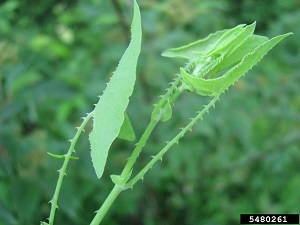|
Nov. 6, 2020
Contact: Joanne Foreman, 517-284-5814 or Susie Iott, 517-420-0473
The Michigan departments of Natural Resources and Agriculture and Rural Development recently confirmed the presence of invasive mile-a-minute weed (Persicaria perfoliata) at Albion College’s Whitehouse Nature Center in Calhoun County.

Mile-a-minute weed, a fast-growing, barbed vine native to India, Asia and the Philippine Islands, was not known to be in Michigan until Doug White, professor of ecology at Albion College, discovered it Oct. 3 in a forest opening on the property while surveying for house wrens.
“I’m not normally out there in October, but we color-banded nestlings this year, and I was following the fledglings,” said White. “I saw these purple and blue fruits on a plant, and I was curious. Years ago, I wrote my dissertation on bird-dispersed fruits, so naturally I wanted to find out what they were.”
White took photos, plucked a branch from the vine and, after some research, determined that this was an invasive plant previously unknown in the state.
A species is considered invasive in Michigan if it is not native and can cause harm to the environment or economy.
|
What is mile-a-minute weed?
Mile-a-minute weed is an annual vine that gets its name from its ability to grow up to 6 inches per day, or 25 feet in six to eight weeks. Its light green leaves are shaped like equilateral triangles, and both the stems and leaf blades are lined with small, recurved barbs that help it climb over other vegetation

Small, inconspicuous white flowers appear in spring, developing into spikes of pea-sized, blue fruits in mid-summer. Unusual circular leaves called ocreae clasp the stems below the fruits.
Mile-a-minute weed thrives in full sun and wet soils, but it can grow in a variety of conditions. Like many invasive plants, it takes advantage of open space and disturbed areas including roadsides, stream banks, forest edges and fence lines.
|
Why is it a problem?
The vine’s fast growth and climbing habit allow it to overtake native and landscape vegetation, eventually smothering plants and trees under dense, prickly thickets. Because of the risk to Michigan’s Christmas tree farms, reforestation projects and habitat restoration areas and the plant’s limited distribution, mile-a-minute weed is on the state’s invasive species watch list.
How did mile-a-minute weed get here?
The first established population of mile-a-minute weed was found in a Pennsylvania nursery in the 1930s, likely brought to the location in contaminated nursery stock. Because the fruit is attractive to birds, deer and small mammals, seeds are easily spread miles away from the original plants. Mile-a-minute weed infestations have been reported in 15 states across the United States. The closest known infestation is in northern Ohio.
What is being done?
DNR and MDARD staff are working with regional partners, including Cooperative Invasive Species Management Areas, Albion College faculty and staff and other landowners to determine the distribution and extent of the infestation.

The infestation at the Whitehouse Nature Center will be managed by Albion staff and students who will manually remove the vines. BCK CISMA, serving Barry, Calhoun and Kalamazoo counties, along with JLW CISMA in neighboring Jackson, Lenawee and Washtenaw counties, will assist in outreach and identification of other potential sightings.
Though mile-a-minute weed can be removed by hand, seeds can persist in the soil for up to six years, so infested sites need to be monitored regularly for regrowth. New shoots can be mowed or tilled in the spring or early summer before fruiting, as even immature green fruits can carry viable seed and create new plants.
|
How can people help?
Though most vegetation is now dying back, mile-a-minute weed fruits may still be visible on the vine, and barbs will be present on stems and leaf blades. Anyone encountering a vine that could be mile-a-minute weed should visit Michigan.gov/Invasives to review identification information. If the plant appears to be mile-a-minute weed, take photos, note the location and report the find using one of these methods:
For more information on mile-a-minute weed and other invasive species of concern in Michigan, visit Michigan.gov/Invasives.
Michigan's Invasive Species Program is cooperatively implemented by the Department of Environment, Great Lakes, and Energy, the Department of Natural Resources; and the Department of Agriculture and Rural Development.
/Note to editors: Accompanying photos are available below for download. Suggested captions and photo credit information follow:
Plant: Mile-a-minute weed is a vine that can be identified by its triangular leaves and spikes of blue, pea-sized fruit. Photo courtesy of Leslie J. Mehrhoff, University of Connecticut, Bugwood.org.
Fruit: Blue fruit grows in spikes above a circular, clasping leaf. Each fruit contains one black seed. Photo courtesy of Leslie J. Mehrhoff, University of Connecticut, Bugwood.org.
Barbs: Recurved barbs line mile-a-minute weed vines and leaf margins. Photo courtesy of Leslie J. Mehrhoff, University of Connecticut, Bugwood.org.
|